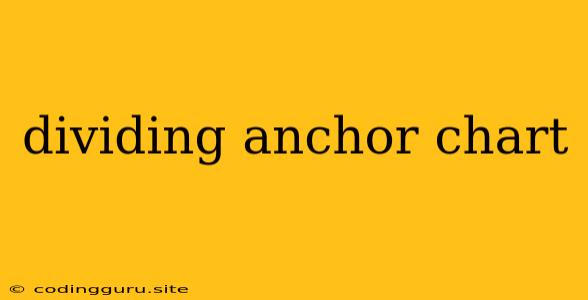Understanding the Concept of Dividing
Dividing is a fundamental mathematical operation that involves splitting a whole into equal parts. It's a key concept in everyday life, from sharing snacks with friends to calculating how much fabric you need for a project.
Why Use a Dividing Anchor Chart?
A dividing anchor chart is a visual tool that helps students understand and remember the different parts of a division problem. It's particularly helpful for beginners who are still grappling with the concept. This visual representation can break down the process into smaller, more manageable steps, making it easier to grasp.
What Does a Dividing Anchor Chart Include?
A typical dividing anchor chart will include:
- The Dividend: This is the number that is being divided. It represents the total number of items you are splitting.
- The Divisor: This is the number that you are dividing by. It represents the number of equal groups you are making.
- The Quotient: This is the result of the division. It represents the number of items in each group.
- The Remainder: This is the number that is left over after the division is complete. It represents the number of items that couldn't be evenly divided.
Example of a Dividing Anchor Chart
Let's take an example: 12 cookies divided into 4 groups.
| Dividend: 12 Cookies | Divisor: 4 Groups | Quotient: 3 Cookies per group | Remainder: 0 Cookies |
The anchor chart helps visualize the process:
- 12 cookies are divided into 4 groups.
- Each group has 3 cookies (the quotient).
- There are no cookies left over (the remainder is 0).
Benefits of Using a Dividing Anchor Chart
Using a dividing anchor chart offers several benefits:
- Visual Aid: The chart provides a clear visual representation of the division process, making it easier for students to understand.
- Easy Reference: Students can refer to the chart anytime they need a quick reminder of the components of a division problem.
- Improved Understanding: By breaking down the process into smaller steps, the chart helps students build a strong foundation in division.
- Enhanced Engagement: The visual nature of the chart can make learning division more engaging and interactive.
Creating a Dividing Anchor Chart
Creating a dividing anchor chart is simple:
- Gather Materials: You'll need a large piece of paper, markers, and color pencils.
- Define the Components: Clearly label the dividend, divisor, quotient, and remainder.
- Use Visuals: Add simple drawings or illustrations to represent the division process.
- Provide Examples: Include several examples of division problems to illustrate the concept.
Tips for Using a Dividing Anchor Chart
- Engage Students: Encourage students to actively participate in creating and using the chart.
- Explain the Concept: Clearly explain the meaning of each component of the chart.
- Practice Regularly: Use the chart to reinforce division skills through regular practice exercises.
- Adapt to Different Levels: Tailor the complexity of the chart to the students' understanding level.
Conclusion
A dividing anchor chart is a valuable tool for teachers and students to learn and understand the concept of division. Its visual representation, clear labeling, and step-by-step explanation make it easier to grasp this fundamental mathematical concept.
